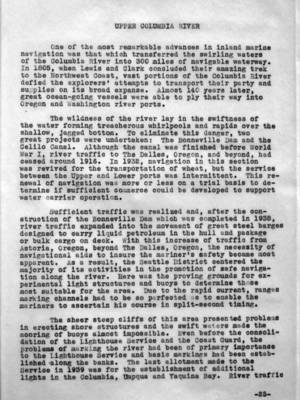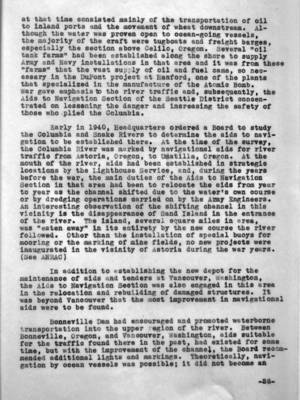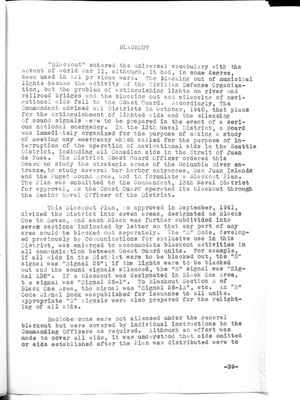Pages That Mention Seattle District
Coast Guard District narrative histories 1945
37
The early conception of the mariners, that all aids to navigation must be received by the normal senses of sight and sound, was radically changed by the development of the radiobeacon system which has, since its inception in 1921, become recognized as a most important innovation for increased safety for mariners. As radio signals are not obscured by fog, wind, rain, snow or temperature changes, and bearings may be taken at great distances far beyond the horizon, the radiobeacon had great advantages over previous types of navigational aids. Proof of its efficiency lay in the fact that since its inception approximately a quarter of a century ago, the radiobeacon system was adopted by all maritime nations and direction finders were developed to fit not only the requirements of large ocean liners, but small pleasure craft and fisherman's vessels as well.
At the time of the consolidation of the Lighthouse Service and the Coast Guard, the Seattle District operated nine-land-based radiobeacons and four radiobeacons on the lightships at Swiftsure Bank, Umatilla Reef and the entrance to the Columbia River. Two beacons were under construction at Destruction Island (completed in 1943) and at Willapa Bay (completed in 1941). Two more radiobeacons were authorized in 1842, one at Cape Flattery (Tatoosh Island) and one at West Point. In the middle of 1945, the radiobeacon at Ediz Hook was established, bringing the total number of District radiobeacons to 18. However, at the onset of the war, the Navy removed the lightships from Umatilla Reef and Swiftsure Bank thus leaving only 16 beacons in operation. Of these 16, one was maintained by the RELIEF LIGHTSHIP and used alternately on the Columbia River station.
In an effort to increase, to even a greater degree, the efficiency of the radiobeacon system throughout the United States, headquarters urged that a monitor system be developed and put into operation in each District. Subsequently, a monitor station was established at North head Radio Station which checked the performance of all District radiobeacons. Between 0800 to 1100 and 1500 to 1900 daily, each radiobeacon was monitored, the time for the check being staggered to insure a truer picture of the various beacons' performance. Outlying stations were notified daily of all failures or defects in the radiobeacons' operation. These reports were a District innovation and were not required by Headquarters but were merely another measure adopted by the District Coast Guard Office for increased efficiency in the District system.
-18-
44
One of the most remarkable advances in inland marine navigation was that which tranferred the swirling waters of the Columbia river into 300 miles of navigable waterway. In 1805, when Lewis and Clark concluded their amazing trek to the Northwest Coast, vast portions of the Columbia River defied the explorers' attempts to transport their party and supplies on its broad expanse. Almost 140 years later, great ocean-going vessels were able to ply their way into Oregon and Washington river ports.
The wildness of the river lay in the swiftness of the water forming treacherous whirlpools and rapids over the shallow, jagged bottom. To eliminate this danger, two great projects were undertaken: The Bonneville Dam and the Celilo Canal. Although the canal was finished before World War I, river traffic to The Dalles, Oregon, and beyond, had ceased around 1916. In 1932, navigation in this section was revived for the transportation of wheat, but the service between the Upper and Lower ports was intermittent. This renewal of navigation was more or less on a trial basis to determine if sufficient commerce could be developed to support water carrier operation.
Sufficient traffic was realized and, after the construction of the Bonneville Dam which was completed in 1938, river traffic expanded into the movement of great steel barges designed to carry liquid petroleum in the hull and package or bulk cargo on deck. With this increase of traffic from Astoria, Oregon, beyond The Dalles, Oregon, the necessity of navigational aids to insure the mariner's safety became most apparent. As a result, the Seattle District centered the majority of its activities in the promotion of safe navigation along the river. Here was the proving grounds for experimental light structures and buoys to determine those most suitable for the area. Due to the rapid current, ranges marking channels had to be so perfected as to enable the mariners to ascertain his course in split-second timing.
The sheer steep cliffs of this area presented problems in erecting shore structures and the swift waters made the mooring of buoys almost impossible. Even before the consolidation of the Lighthouse Service and the Coast Guard, the problems of marking the river had been of primary importance to the Lighthouse Service and basic markings had been established along the banks. The last allotment made to the Service in 1939 was for the establishment of additional lights in the Columbia, Umpqua and Yaquina Bay. River traffic
-25-
45
at that time consisted mainly of the transportation of oil to inland ports and the movement of wheat downstream. Although the water was proven open to ocean-going vessels, the majority of the craft were tugboats and freight barges, especially the section above Celilo, Oregon. Several "oil tank farms" had been established along the shore to supply Army and Navy installations in that area and it was from these "farms" that the vast supply of oil and fuel came, so necessary in the Dupont project at Hanford, one of the plants that specialized in the manifacture of the Atomic Bomb. War gave emphasis to the river traffic and, subsequently, the Atomic Bomb. War gave emphasis to the river traffic and, subsequently, the Aids to Navigation Section of the Seattle District concentrated on lessening the danger and increasing the safety of those who plied the columbia.
59
"Blackout" entered the universal vocabulary with the advent of World War II, although, it had, in some degree, been used in all previous wars. The blacking out of municipal lights became the activity of the Civilian Defense Organization, but the problem of extinguishing lights on river and railroad bridges and the blacking out and silencing of navigational aids fell to the Coast Guard. Accordingly, The Commandant advised all Districts in October, 1940, that plans for the extinguishment of lighted aids and the silencing of sound signals were to be prepared in the event of a serious national emergency. In the 13th Naval District, a Board was immediately organized for the purpose of making a study of meeting any emergency which called for the purpose of interruption of the operation of navigational aids in the Seattle District, including all Canadian aids in the Strait of Juan de Fuca. The District Coast Guard Officer ordered this Board to study the Strategic areas of the Columbia River entrance, to study several bar harbor entrances, San Juan Islands and the Puget Sound Area, and to formulate a Blackout Plan. The Plan was submitted to the Commandant, 13th Naval District for approval, as the Coast Guard operated its blackout through the Senior Naval Officer of the District.
This Blackout Plan, as approved in September, 1941, divided the District into seven areas, designated as Blacks One to Seven, and each Black was further subdivided into seven sections indicated by letter so that any part of any area could be blacked out separately. The "S" Code, developed previously by Communications for exclusive use in this District, was enlarged to accommodate blackout activities in all communication between Coast Guard units. For example, if all aids in the District were to be blacked out, the "S" signal was "Signal 26"; if the lights were to be blacked out and the sound signals silenced, the "S" signal was "Signal 138". If a blackout was designated in Black One Area, the signal was "Signal 26-1A", etc. An "S" Code Signal Book was published for issuance to all units. Appropriate "S" signals were also prepared for the relighting of all aids.
Radiobeacons were not silenced under the general blackout but were covered by individual instructions to the Commanding Officers as required. Although an effort was made to cover all aids, it was understood that aids omitted or aids established after the Plan was distributed were to
-39-



